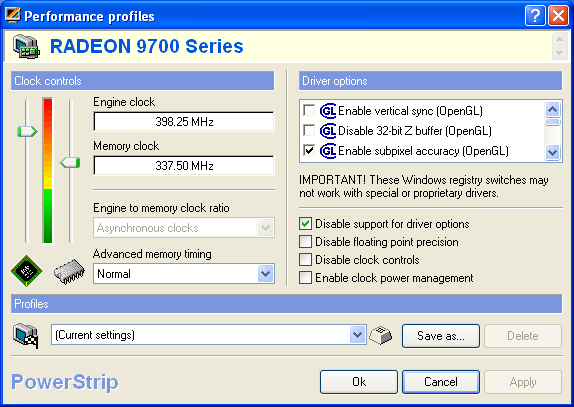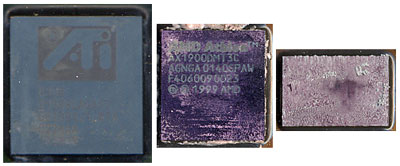Gigabyte's Radeon 9700 Pro - Hitting 400MHz
by Anand Lal Shimpi on August 22, 2002 1:34 AM EST- Posted in
- GPUs
Overclocking
Normally whenever we do an individual graphics card review we like to try and overclock the GPU to test the effectiveness of the cooling system. Being that the R300 is a brand new core and most overclocking utilities don't support brand new architectures until they have actually been available for a while, we didn't expect to be able to overclock the GV-R9700Pro. Much to our surprise, the latest version of Powerstrip (3.20) properly detects and supports overclocking the R300.
Powerstrip reported the core clock speed properly at 325MHz and reported the actual operating frequency of the memory at 310MHz (remember that the memory actually runs at 310MHz even though it transfers data twice per clock, which is why it is sometimes called 620MHz memory).
We played around with the settings and managed to overclock the R300 to an incredible 400MHz, an increase of 23%. The memory was only able to hit 337MHz DDR (effectively 674MHz), an increase of 8% but the core overclock was by far the most impressive of the two numbers.

One of the reasons that the overclock was so impressive is because of the sheer size of the R300 GPU itself. Remember that we're talking about a 110M transistor GPU built on a 0.15-micron process; we were shocked when ATI announced that they would be able to hit 325MHz on retail boards, but when we managed to reach 400MHz on the GV-R9700Pro we were amazed to the point of extreme skepticism.
R300 Core Size Comparison

From left to right - 0.15-micron R300 GPU, 0.18-micron Athlon XP "Palomino"
CPU, 0.13-micron
Athlon XP "Thoroughbred-B" CPU
In order to put our worries to rest, we then tried overclocking ATI's Radeon 9700 Pro card - the same card we used in our review. While we couldn't hit 400MHz on this card, we managed to get as high as 378MHz reliably. Without any additional cooling, this gave us a good deal of faith in ATI's ability to deliver an even higher clocked version of the R300 on their current 0.15-micron process. Should NVIDIA make an impressive showing of NV30 before the end of this year, it would not be out of ATI's reach to release a 350 - 400MHz R300 with faster memory to compete without any significant changes to the core.
It's clear that ATI is well aware of this potential of the R300, which is why they told us months ago that when the NV30 launches they will have something even faster up their sleeves. ATI doesn't need a 0.13-micron process to ramp up the clock speed of the R300, but they will need faster memory. Our astounding overclocking successes don't kill the need for a 0.13-micron R300, since ATI will eventually need to outfit each of their 8 rendering pipelines with a second texture unit once the move to faster DDR/DDR-II memory is made. What these results do mean however is that if the need arises, ATI can squeeze a bit more out of the current R300 (and so can you).










0 Comments
View All Comments